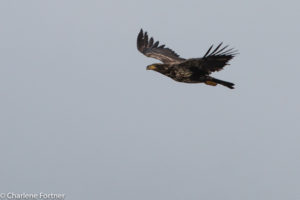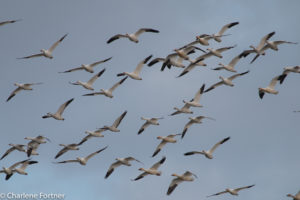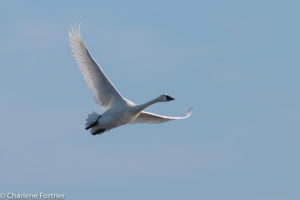What started out as a windy, overcast day in the Outer Banks of North Carolina ended up being one of the most spectacular birding days I’ve had in a while. We were the first car in the parking lot at Pea Island NWR, North Pond Wildlife Trail, at 0825. It looked to be a dreary day with a slight wind. Thankfully the wind was blowing mostly east so it wasn’t kicking up too much sand.
Our initial observations were the number of Tundra Swans and the deafening noise of the hidden Snow Geese. Walking along the wildlife trail under the foliage we caught sight of a few Yellow-rumped Warblers. Close to the shore there were nearly 50 Tundra Swans, mostly butts up, in a “sea” of American Coots. Scattered among various flocks were Northern Pintails and Buffleheads. A few Pied Grebes were spread out as singletons. While walking to the first boardwalk (overlooking the New Field Pond) there were several flyovers of Pintails, Redheads, American Black Ducks and American Wigeons. Even a few White Ibis could be seen crossing from the North Pond over the trail. Before checking out the southern pond a large raucous began to the North. The Snow Geese had begun lift-off from the east. Soon, hundreds of Snow Geese and other ducks were flying above the pond. The culprit for their sudden, and rather loud, mass exodus were a pair of bald eagles.
It took more than 10 minutes for the pond to quiet down again. The Snow Geese continued to circle the pond in large flocks of 100-300 ducks each. By the time the ducks and geese had settled, the Tundra Swans close to the shore had moved off and we reached the observation tower at the end of the wildlife trail. Four American White Pelicans were feeding near the corner of the pond. A Northern Harrier was completing a low-flying pass along one of the small grass islands. From the tower I managed to take a five-photo series which I later stitched into a panorama (in Adobe Lightroom), seen below. At this junction we decided to continue north along the shore of the pond. Small slivers of daylight were peeking through the clouds and if the clouds continued moving it was possible that our weather and photographic conditions would get a major boost.
A large group of Coots were the first large flock we came across as we headed north. It is funny how Coots respond when you approach them. Unlike the ducks who mostly fly off, the Coots seem to run over the water without taking off.
Yesterday I was able to identify Marbled Godwits only as little blobs in a photo, after the fact. Just as the sun was beginning to come out, and stay out, I noticed a shape moving in and out of a grouping of Tundra Swans and Canada Geese. I was very excited to find a lone Marbled Godwit feeding near a shoal. Shortly after we were able to identify a small flock of an additional 13 godwits resting close to a small island in the middle of the pond.
About this time something must have spooked the Snow Geese again as a large flock soared into the sky making several passes along the eastern side of the pond. By the time they were done I had disappointingly lost sight of the lone godwit.
As we continued North along the pond’s edge the sun was out and cloud coverage was almost completely gone. We came up to a small island close to the edge which provided perfect cover for several herons. We spooked them as we got closer. We could originally see an immature Little Blue Heron and a Tricolored Egret. After spooking the first two, an additional Tricolored, a Snowy Egret, White Egret and a Great Blue Heron also were hidden along the reeds by the shore. A few fly-by Tundra Swans in favorable light.
We continued north and flushed a small group of Eastern Meadowlarks. They flew further down on the path. Amazingly they blended in seamlessly and we lost them until we flushed them again. We soon began discussing whether we wanted to continue walking all the way around the North Pond or turn around. We could still see the visitor center in the distance accross the pond and the far corner of the pond to the north was also visible. If we continued we would have to walk a sizeable distance along the road and dunes without too much prospect of finding any birds. We ultimately turned around and began back-tracking to the observation tower. This move caused us to face the sun (and take on a little sunburn). Occasionally, I would try and track the busy Buffleheads as they flew back and forth.
After arriving back to the main wildlife trail we happened upon a pair of birders taking a respite on a bench. They were very nice and we chatted about what we had seen and they informed us what they had seen over the past few days. They informed us about a blind along the road north of the visitor center before getting to the pull out for the Salt Flats Trail. The blind was visible when traveling from the south. After we arrived and parked by the side of the road we had to climb over a dune to get to the blind. To my surprise, there were many different species very close to the blind. The highlight was excellent views of two Marbled Godwits!
After nearly four hours of birding and running out of space on my SD card we returned to the hotel for lunch. We returned to this location later in the day along with Bodie Island Lighthouse. We saw fourty-four species in one morning with large quantities for most of them; making for an interesting day full of fantastic photographic opportunities. More photos to come later, included a series of godwit photos!











